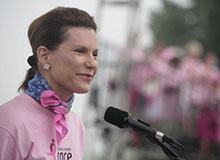Nancy Goodman Brinker did not know what she was getting into when she promised her older sister, Susan G. Komen, that she would do whatever she could to find a cure for breast cancer. Komen died of the disease at age 36 in 1980.
“I was 33 years old and devastated by the loss of my sister and best friend,” said Brinker, speaking at a recent Wharton Leadership Lecture. “Our father had long preached that you never give up, you never lose your focus, but this was definitely something new, a big challenge that I felt obligated to undertake.”
Within two years, Brinker had started Susan G. Komen for the Cure, the foundation which has raised nearly $2 billion primarily for breast cancer research. She has gone from a Neiman Marcus sales person to an internationally known diplomat and foundation chair — not because she knew anything about the non-profit world going in, she noted, but because she zeroed in on learning, sometimes through trial and error.
And she never lost sight of the goal set by her sister.
Getting the Message Out
“When we started, you could not even say the word ‘breast’ in the media, not even on public television…,” said Brinker. Nor did people want to talk about breast cancer, “with the death rate so high and only a few drugs at the time that worked. Mammography was about the only technique we had that was progressive. So I decided to think of how to convey conventional messages in unconventional ways.”
For example, because her sister’s favorite color was pink, that became a brand for the Susan G. Komen message. And she tried to get a mention of the subject in a variety of different places. “Maybe we would discuss side effects and outcomes” of various treatments,” Brinker recalled. “Or we would get on sports shows about women and try to get in something about breast cancer. We would get producers to put it in a story line in soap operas. We would try to tailor our message to men in government, which was most of [Washington] D.C. at the time. We would get attractive celebrities to comment — maybe someone who had breast cancer in the family, but always someone who spoke well. It was an all-encompassing effort.”
Brinker, too, had to figure out how to be a leader despite her lack of training, but she always remembered her father’s admonition to find a niche and be the best with whatever talent or skills you had.
That turned out to be a job at Neiman Marcus in Dallas, where Brinker’s husband, Norman, had chosen to base his restaurant career. While there were few jobs of note for women at the time, Brinker said, she took one at Neiman Marcus because its founder, Stanley Marcus, had famously said that there were no glass ceilings for women in his stores. Brinker acknowledged not being the most glamorous sales person, but noted that she was aggressive about offering customers many different models of dresses to try on, culled from both the stock room and the sales floor. “As my father [advised], I did the best with what I had. You develop a niche, and that is what you focus on.”
Such an approach, she added, is one of her main criteria for leadership — concentrating on the goal. “Do not get distracted. There will be setbacks along the way. Nothing is perfect,” said Brinker. Over the years, she has developed a close relationship with former First Lady Laura Bush. When George W. Bush’s term as president was over, Laura Bush asked Brinker what she thought she should do with her post-White House time. “I told her to pick one goal and really focus on it,” noted Brinker. “There are so many things that can be distracting; we have to control what we can control and let those distractions go.”
A leader must also know what the goal is before starting out, states Brinker. “It seems simple to say that you should start with the end in mind, but so many people have not figured out where they want to end up, and the goal does not get reached.”
A ‘Giant Misstep’
Norman Brinker, from whom Nancy Brinker was amicably divorced in 2003 and who died in 2009, was a large Republican donor. Nancy Brinker eventually landed two influential government jobs in the George W. Bush administration — first as U.S. Ambassador to Hungary and second as chief of protocol.
When Brinker was named ambassador to Hungary, she thought her main mission would be to bring the word of the Komen Foundation to Eastern Europe, where treatment for, and awareness of, breast cancer was still in its infancy. “This was a mid-level country which could be on the verge of doing better. I was all set to get the NGOs [non-governmental organizations] involved and really excited,” she said. On the morning she was due to fly to Budapest, she caught part of a news report about a plane hitting a building. It was September 11, 2001. “Things became a little different in Eastern Europe, and I had to change that plan a bit.”
Despite her high-level government jobs, Komen said that she has never lost focus on her main ambition to rid the world of breast cancer. The five-year survival rate in the United States, she noted, has gone from mid-70% to more than 90% during her time with Susan G. Komen for the Cure.
She also said she never ignores criticism, but tries to use it to strengthen the foundation and its message. Last year, the group announced it intended to cut way back on financial support to Planned Parenthood, an organization that provides breast cancer screenings and other services — including abortions — to many low-income women. The anger — and threatened drop in donations — that this announcement generated among women all across the country eventually led Brinker to reverse the foundation’s decision.
“Fortunately, that is over now,” Brinker said, adding that she apologized in public and to Planned Parenthood, suggesting that the problem was bad timing. “We had funded 16 initiatives there and wanted to reinvent them. We were not tailored to politics, just to our mission, and we made a giant misstep for which I am sorry. It taught me that you have to pay attention to the small things, to how you use every word, or it can bring you down. I think we are back on track now,” she noted.
The Planned Parenthood controversy also made her more aware of the implications of social media, like Twitter and Facebook, which she feels advanced the controversy more quickly than she could handle it.
The message of Susan G. Komen has to keep pace with change, too, Brinker noted. Part of that is trying to tailor the language the foundation uses to younger women. “We do not use ‘victim,’ because everyone is a ‘survivor’ even if she is dying,” she said. “I do not want to make people feel like failures. We have been criticized for that, but the language we use is for a different generation now. Patients want to be more relevant to themselves and their families. They are more empowered and educated than women were back when we started.”
Even so, she added, “women need comfort and a way to cope with the disease. You do not just boost them up with dressing in pink or being in a race. It is a more complicated world.”
Brinker is worried, however, that the foundation’s success in getting nearer and nearer to her original goal may in some way be responsible for cutbacks in research funding. While Susan G. Komen has made some donations toward cervical cancer and other women’s illnesses, the main focus is still the eradication of breast cancer.
The need is to “really focus, focus, focus on the goal,” she said, noting that there are many ways research can go — from traditional medicinal tests to holistic medicine to psychological profiles on whether stress can cause cancer. “But I am worried, and not hopeful, about the current state of cancer research. The very people we invested in to get the proper education — to build careers in research — cannot get a grant from the government anymore. Not that working in technology is a bad thing, but are these people going to get frustrated and start developing killer apps for Apple instead? We tried to create a movement, but if we are going to lose a generation of brilliant people, where have we come?” she asked. “That is why I can’t stop until my goal — my promise to my sister — is finally reached.”



